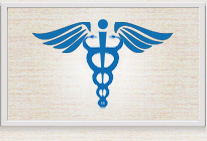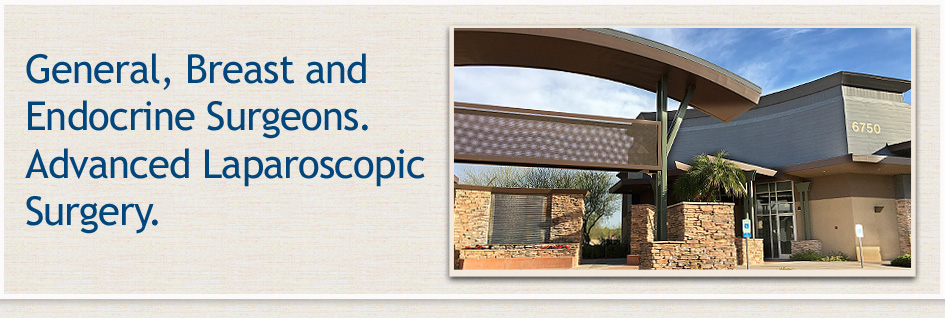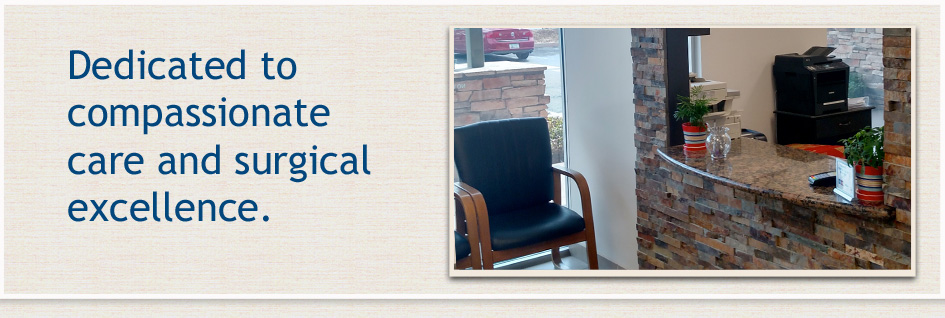Colon and Rectal Conditions
Doctors Allen A. Agapay and Jordan J. Glenn are experts in the diagnosis and treatment of colon and rectal problems, including colon cancer, benign growths (polyps), hemorrhoids, anal fissures and fistulas, bowel obstruction, and diverticulitis. The team offers comprehensive, supportive, state-of-the-art care to surgically treat problems when necessary. Their focus on minimally invasive surgical techniques for colorectal surgery contributes to better outcomes and quicker recovery time.
Polyps of the Colon
Colonic polyps are extra pieces of tissue that grow on the lining of the colon that are usually discovered during a colonoscopy or after a patient is examined due to symptoms. While most polyps are harmless, some may become cancerous, so it's important to have regular screening tests. Colon polyps found in the early stages can usually be removed safely and completely.
Symptoms
- A change in bowel habits
- Blood in the stool or change in stool color
- Frequent gas pains, bloating, fullness, or cramps
- Constipation or diarrhea lasting more than a week
- Pain, nausea or vomiting
Diagnosis
Tests to diagnose tumors of the colon include:
- A colonoscopy - Your doctor uses a thin, flexible tube called a colonoscope to look at the colon. During the procedure, your doctor may perform a biopsy.
- X-rays
- Ultrasound of the rectum
- MRI scan of the abdomen and/or pelvis
- CT colonography - a minimally invasive test that uses a CT scan to view your colon
- Flexible sigmoidoscopy - a slender, lighted tube is inserted in your rectum to examine it and the last third of your colon (sigmoid).
Treatment
Treatment is usually localized surgery to remove the polyp or the portion of colon that contains it.
Hemorrhoids, Anal Fissures, and Fistulas
There are some common problems, including hemorrhoids, anal fissures and fistulas that can occur in the area from the rectum to the anus.
Hemorrhoids are clusters of blood vessels and fibrous tissue that help control the passage of stool through the anal canal. Problems occur when the veins, arteries, and surrounding tissue become swollen and extend into the anal canal.
Symptoms
- bleeding after a bowel movement
- blood in the stool
- anal itching, pain or discomfort
Diagnosis
Besides a physical and rectal exam, your doctor may recommend a colonoscopy, sigmoidoscopy or barium enema x-rays for further diagnosis.
Treatment
For extreme cases the best treatment for hemorrhoids is colorectal surgery to excise the hemorrhoid from the wall of the anal canal. During surgery, your doctor will locate where the artery flows to the hemorrhoid, tie off the artery and stitch or staple the hemorrhoid back into to its natural position.
An anal fissure is a tear in the skin of the anus that causes pain and bleeding with bowel movements.
Symptoms
- pain during a bowel movement
- bleeding from the anus
- a crack in the skin of the anus that is visible when the skin is stretched
- constipation
Diagnosis
Besides a physical exam, your doctor may recommend a colonoscopy or sigmoidoscopy for further diagnosis.
Treatment
When anal fissures are chronic, surgery is recommended. A sphincterotomy is the surgical procedure most commonly used to repair a fissure. This is a minor operation which can be carried out under either local or general anesthesia.
An anal fistula is a tunnel-like passage from the outer skin of the anus to the anal canal or inner rectum. If left untreated, a fistula can branch off into multiple openings.
Symptoms
- pain, redness and swelling of the skin around the anus
- Persistent drainage of blood, pus or foul-smelling mucus from the anal area
- fatigue
- fever or chills
Diagnosis
Besides a physical and rectal exam, your doctor may recommend a colonoscopy, sigmoidoscopy or barium enema x-rays for further diagnosis.
Treatment
A small fistula can be treated using local anesthesia. Larger fistulas are operated on in the hospital, using spinal or general anesthesia. During the operation, your surgeon will open up the fistula and remove infected tissue so that the wound can heal.
Colorectal Cancer
Colorectal cancer is a cancer that starts in the colon or the rectum. When caught early, colorectal cancer is often curable. With laparoscopic technology, surgery can be performed with small incisions and a much shorter recovery time.
Symptoms
Signs and symptoms of colorectal cancer include:
- Rectal bleeding or blood in your stool
- Changes in bowel movements
- Abdominal pain or discomfort such as frequent gas pains, cramps, bloating, or feeling of fullness
- Diarrhea, constipation, or the feeling that the bowel does not empty completely
- Unexplained weight loss
- Weakness or fatigue
- Vomiting
Diagnosis
Tests to diagnose tumors of the colon include:
- Colonoscopy: A procedure to examine the rectum and entire colon for polyps, abnormal areas, or cancer using an instrument called a colonoscope. In addition to a light and a lens for viewing, a colonoscope has a tool to remove polyps or tissue samples.
- Virtual colonoscopy: A procedure that is done with an external scanning machine. It provides a series of detailed pictures of the colon that may show polyps and anything else that seems unusual on the inside surface of the colon.
- Sigmoidoscopy: A procedure to examine the rectum and lower colon (called the sigmoid colon) for polyps, abnormal areas, or cancer using a slender lighted instrument called a sigmoidoscope.
- Barium enema: A series of x-rays of the lower gastrointestinal tract. A liquid that contains barium is put into the rectum. The barium coats the lower gastrointestinal tract and x-rays are taken. This procedure is also called a lower GI series.
Treatment
Most people with colon cancer begin treatment with surgery to remove their cancer. Doctors Agapay and Glenn will provide you with the most effective, least invasive treatment.
Surgical procedures the doctors perform include:
Local excision: When cancer is found at a very early stage, the surgeon may remove it through a tube inserted through the rectum into the colon.
Laparoscopic Resection: During a laparoscopic colon resection, your doctor makes a few small incisions through which he removes the cancer and a small amount of healthy tissue around it. He then staples together the ends of the healthy colon that are left.
Robotic-Assisted Colon Resection: This is a minimally invasive procedure for colon resection. Your surgeon controls robotic arms with attached surgical instruments and a tiny camera that gives a 3D view inside your body. The robotics enable your surgeon to have very precise control and surgery can be performed through small incisions, so recovery time is swifter than with a standard laparoscopic surgery.
Resection and colostomy: If, after the resection is completed, not enough healthy colon remains for the two ends of the colon to be sewn back together, the surgeon makes an opening in the abdomen for waste to pass through. A bag is placed around the opening to collect the waste. This procedure is often temporary and can be reversed with another operation.
Diverticulitis
Diverticulitis occurs when small pouches called diverticula that have formed on the wall of the colon become infected or inflamed. Severe or recurring diverticulitis may require surgery.
Symptoms
Symptoms of diverticulitis may start suddenly and worsen quickly. They include:
- Pain in the abdomen (usually the lower left side)
- Bloating or gas
- Chills and fever
- Nausea and vomiting
- Change in bowel habits
Diagnosis
Diagnostic tests may include:
- CT scan
- Abdominal ultrasound
- X-rays of the abdomen
- Colonoscopy
- Sigmoidoscopy
- Barium enema
Treatment
In the case of recurring diverticulitis or an abscess, perforation, or fistula, surgery may be required to remove the diseased part of the colon. Doctors Agapay and Glenn perform minimally invasive techniques that result in less post-operative pain and quicker recovery time.
Surgical procedures the doctors perform include:
If there is an abscess, the doctor may need to drain the fluid by inserting a needle into the infected area. Sometimes surgery is needed to clean the abscess and remove part of the colon.
Laparoscopic Resection: In this operation, the surgeon removes the diseased part of your colon and reconnects the healthy segments.
Robotic-Assisted Colon Resection: This surgery can be performed through very small incisions, which usually means a quicker recovery time for patients. During surgery, your surgeon controls a robot equipped with long, thin instruments and a tiny camera. The camera gives your doctor a close-up, 3D view inside your body, and the robotic instruments provide very precise control during the operation.
Resection and colostomy: In cases where there is too much inflammation in the colon for the ends to be rejoined, the surgeon makes an opening in your abdomen for waste to pass through into a colostomy bag. After the inflammation has had time to heal, your surgeon may be able to operate again to reconnect the ends of the colon.

Insurances We Accept
Click the "Learn More" link below for a full list of the insurance plans we accept. If you don’t see your plan on the list, or if you have any questions, please call us at 602-843-8317. Learn More

Arizona Advanced Surgery
Doctors Agapay and Glenn are proud to be a division of Arizona Advanced Surgery. Learn More



